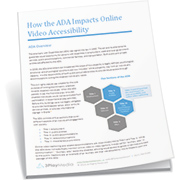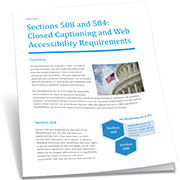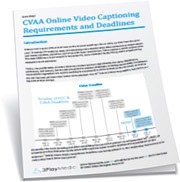Legal Requirements for Audio Description
Updated: August 23, 2024
As technology continues to advance at rapid paces and become integrated into every aspect of our daily lives, it is becoming more and more crucial to make this technology accessible. It’s important to stay on top of the legal requirements surrounding web accessibility in order to provide the necessary accommodations to individuals with disabilities, as well as to be in compliance with the laws and avoid potential lawsuits. With several different laws surrounding accessibility, you may find it hard to figure out what exactly you should be doing. Here’s a rundown of laws that apply to audio description.
Anti-Discrimination Laws
In the US, video accessibility is required under several anti-discrimination laws. These audio description laws are the same laws that require closed captioning for video. This includes the 21st Century Video Accessibility Act (CVAA), the Americans with Disabilities Act (ADA), and Section 504 and Section 508 of the Rehabilitation Act.
Additionally, the Web Content Accessibility Guidelines (WCAG) 2.0, the international standard for web accessibility, requires audio description under guideline 1.2 for time-based media. WCAG 2.0 is the legal requirement under the revised Section 508 standards and is often required by state laws. Most web accessibility experts recommend striving for WCAG 2.0 Level AA compliance, which requires audio description be provided for all prerecorded video content in synchronized media.
Americans with Disabilities Act (ADA)
The Americans with Disabilities Act (ADA) guarantees equal opportunity for individuals with disabilities in employment, state and local government services, public accommodations, commercial facilities, and transportation. The ADA is made up of five categories called “Titles” that address each of these different areas.
Although the ADA doesn’t explicitly talk about web accessibility (after all, it was signed into law in 1990), Title II and Title III are known to most closely relate to web accessibility. Title II prohibits disability discrimination by all public entities at the local and state level, including schools, courts, police departments, public libraries, and public universities. Compliance is required regardless of whether or not these entities receive federal funding. Title III prohibits disability discrimination by “places of public accommodation,” which include shared or public entities such as libraries, universities, hotels, museums, restaurants, retail stores, and transportation services that are privately owned.
While the ADA doesn’t specifically name audio description as a requirement, it states that governmental organizations must ensure “effective communication” with citizens, including providing the necessary assistive technology to do so. Additionally, it calls for “auxiliary aids” in communication to assist the disabled and allow equal access to goods and services that are provided to the public, thus requiring audio description be provided for visual content that would otherwise prohibit low vision or blind individuals from having equal access to the content.
Section 508 and Section 504 of the Rehabilitation Act
The addition of Section 508 to the Rehabilitation Act requires Federal agencies to make their electronic communications and information technology accessible. Therefore, all film, video, multimedia, and information technology produced or procured by Federal agencies must include audio description. Additionally, Section 508 experienced a refresh, published earlier this year, that updates requirements for information and communication technology covered by Section 508.
The Section 508 refresh, which will take effect in early 2018, assigns WCAG 2.0 success criterion to each existing section of the 508 Standards in an effort to modernize the requirements for both closed captioning and audio description.
Changes to Section 508 include:
- Categorization by functionality instead of by product type
- Revisions to improve ICT usability, including interoperability with assistive technologies
- Clarification on the types of ICT covered
- Correlation of WCAG 2.0 Level A and Level AA standards to all Section 508 requirements
Section 504 protects the civil rights of people with disabilities by requiring that organizations that receive federal funding make accommodations for equal access. For users who are blind or low vision, audio description must be provided.
21st Century Communications and Video Accessibility Act and Federal Communications Commission
In October 2010, Barack Obama signed the 21st Century Communications and Video Accessibility Act (CVAA) into effect, requiring that modern communications technologies be made accessible to all people regardless of vision and/or hearing loss. In implementing the CVAA, the Federal Communications Commission (FCC) put forth a Notice of Proposed Rule Making (NPRM). This Notice set regulations for implementing audio description on video content intended for children and for prime-time viewing. The rules on video description required that ABC, CBS, Fox, NBC, USA, the Disney Channel, TNT, Nickelodeon, and TBS each provide 50 hours of video-described prime time or children’s programming per calendar quarter by 2012. On July 1, 2015, the 50 hours per week requirement expanded to the top 60 TV markets, and the next increase is scheduled for July 1, 2018. The intent is to gradually increase audio description and to have 100% of television programming described by 2020.
Quality Standards
The FCC has learned from their experience with closed captioning, that without firm requirements for caption quality, the accuracy, timing, stylistic approaches, and overall usefulness of closed captioning has fallen drastically. For this reason, the FCC commends several guidelines from the DCMP description key and general guidelines for how to describe, both of which outline key elements and best practices for creating high quality description.
Quality Description Must Be:
- Accurate
There must not be any errors in word choice, pronunciation, diction, or enunciation. - Prioritized
Content essential to the comprehension and enjoyment is of the utmost importance. Description should portray only what is physically observable, rather than motivations or intentions, and should complement the original content. - Consistent
The content, as well as the voicing should match the style, tone, and pace of the program. Patterns should be used for things such as announcing on-screen text and introducing new people. - Appropriate
Keep the intended audience in mind, be neutral, simple, and succinct. - Equal
Equal access requires that the meaning and intention of the program must be conveyed. This also means that the describer should not inject their personal interpretations or opinions.
__
Get started with audio description!









